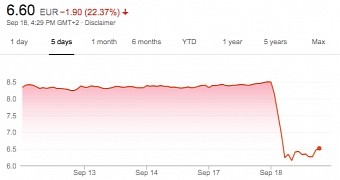According to a Reuters report, TomTom's shares crashed after the Renault–Nissan–Mitsubishi Alliance, decided to adopt Google Maps as the navigation solution in their future car models.
The Dutch navigation company lost $584 million (€500 million) in stock value during a single day of trading, the worst day the company had on the stock market in the last seven years.
The Renault–Nissan–Mitsubishi Alliance signed a deal with Google which would require the search giant to equip the group's future car models with Google Maps- and Google Assistant-powered infotainment systems.
TomTom's loss comes as no surprise seeing that the Dutch company made a considerable amount of its money out of deals with carmakers who wanted map systems for their vehicles' navigation.
Although their main competitor was Garmin until Google entered the navigation maps market, the search giant has since moved into a dominant position, especially after signing the deal with the Renault–Nissan–Mitsubishi Alliance.
TomTom is a supplier of mapping data for Apple and Uber
In September 2012, TomTom signed a deal with Apple to supply Cupertino with map data for their iOS Apple Maps application, in a move designed to replace Google's Maps product, a deal which still stands after being extended in 2015.
TomTom also supplies Uber with mapping data, the Dutch company being the one powering the Uber driver apps with traffic information and maps in more than 300 cities.
Renault–Nissan–Mitsubishi Alliance's change of mind and the choice of Google Maps as the core of their cars' navigation devices might be a result of TomTom's decision at the beginning of 2018 to announce that they will not be providing any more updates for some of their navigation devices and the uncertainty it brought to carmakers who want the longest possible life for all devices they add to their vehicles.
Moreover, TomTom motivated that decision by bringing up the inability of some older devices to run the latest versions of their software and to load newer map versions because of their increasing sizes.

 14 DAY TRIAL //
14 DAY TRIAL //